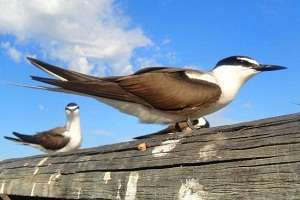Dining habits of breeding terns revealed

Western Australian researchers have used stable isotope ratios from the tail feathers of bridled terns (Onychoprion anaethetus) on Penguin Island to assess how their feeding habits vary during the breeding season.
Increasingly popular with ornithologists, stable isotope analyses provide information on a bird's food web and feeding level from a single capture.
The Murdoch University study took samples upon arrival, before egg-laying, after egg-laying, after hatching and from fledglings.
"It was a beautiful thing to look at the stable isotope graphs and almost be able to super-impose a map on them. Bridled terns remind me of small flying computers and data-loggers," says lead researcher Aurélie Labbé.
"Our research highlighted how bridled terns use different feeding grounds while breeding on Penguin Island, while also showing how much they restrict their diet to specific prey items while raising their chicks.
"The birds feed on almost anything they fancy until they have their chicks, and then they become highly selective of what they eat and what they bring to their young."
The breeding season starts when the adults arrive on the island from the Indonesian Archipelago during the second half of September.
During this time, their diet can be very diverse and include small fish, terrestrial insects, crustaceans – including crab larvae – and cephalopods such as small squids.
When egg-laying begins, their diets become restricted to prey found in the waters offshore and adjacent to the island, with crustaceans and black-spotted goatfish representing a significant portion of their diet in the mid to late parts of the breeding season.
"During the breeding season, they become central place foragers as they must return to their nesting sites from feeding ground to incubate and raise their chicks until the fledglings become independent," Ms Labbé says.
She says the information is important for conservation because it provides a better understanding of how this species uses its environment in WA.
"Bridled terns have been increasing at a very fast pace on Penguin Island since the 1950s. This reflects a change in the climatic and oceanic conditions around this WA ecosystem which has been greatly favourable to the species.
"While many studies focus on endangered species and those threatened by the effects of climate change, species that benefit from global warming also deserve our attention.
"They add a new dimension to the equation of ecosystem dynamics, and we need to know more about them."
More information: Labbé, Aurélie M. T., Dunlop, James N., and Loneragan, Neil R. (2013). "Central place foraging and feather regrowth rate in bridled terns (Onychoprion anaethetus): an insight from stable isotopes." Marine and Freshwater Research 64, 1184–1191. dx.doi.org/10.1071/MF12334
Provided by Science Network WA



















